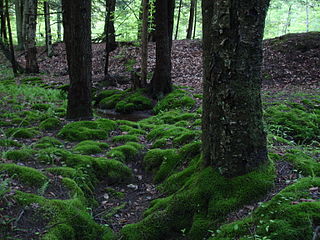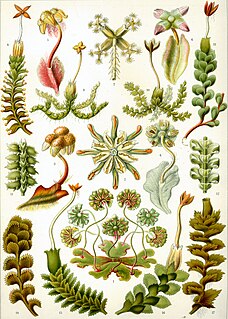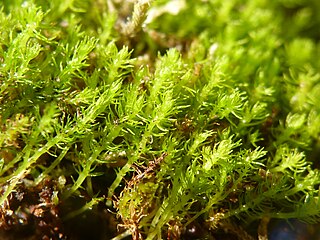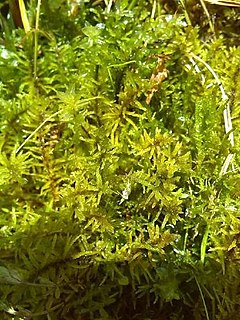The following is a list of published bryophyte floras covering counties or other local areas of Britain, together with a list of vascular plant floras which also contain bryophyte lists.
The following is a list of published bryophyte floras covering counties or other local areas of Britain, together with a list of vascular plant floras which also contain bryophyte lists.

Mosses are small, non-vascular flowerless plants in the taxonomic division Bryophytasensu stricto. Bryophyta may also refer to the parent group bryophytes, which comprise liverworts, mosses, and hornworts. Mosses typically form dense green clumps or mats, often in damp or shady locations. The individual plants are usually composed of simple leaves that are generally only one cell thick, attached to a stem that may be branched or unbranched and has only a limited role in conducting water and nutrients. Although some species have conducting tissues, these are generally poorly developed and structurally different from similar tissue found in vascular plants. Mosses do not have seeds and after fertilisation develop sporophytes with unbranched stalks topped with single capsules containing spores. They are typically 0.2–10 cm (0.1–3.9 in) tall, though some species are much larger. Dawsonia, the tallest moss in the world, can grow to 50 cm (20 in) in height. There are approximately 12,000 species.

Bryophytes are a proposed taxonomic division containing three groups of non-vascular land plants (embryophytes): the liverworts, hornworts and mosses. They are characteristically limited in size and prefer moist habitats although they can survive in drier environments. The bryophytes consist of about 20,000 plant species. Bryophytes produce enclosed reproductive structures, but they do not produce flowers or seeds. They reproduce sexually by spores and asexually by fragmentation or the production of gemmae. Though bryophytes were considered a paraphyletic group in recent years, almost all of the most recent phylogenetic evidence supports the monophyly of this group, as originally classified by Wilhelm Schimper in 1879. The term bryophyte comes from Ancient Greek βρύον (brúon) 'tree moss, liverwort', and φυτόν (phutón) 'plant'.

The Marchantiophyta are a division of non-vascular land plants commonly referred to as hepatics or liverworts. Like mosses and hornworts, they have a gametophyte-dominant life cycle, in which cells of the plant carry only a single set of genetic information.

Takakia is a genus of two species of mosses known from western North America and central and eastern Asia. The genus is placed as a separate family, order and class among the mosses. It has had a history of uncertain placement, but the discovery of sporophytes clearly of the moss-type firmly supports placement with the mosses.
Monoicy is a sexual system in haploid plants where both sperm and eggs are produced on the same gametophyte, in contrast with dioicy, where each gametophyte produces only sperm or eggs but never both. Both monoicous and dioicous gametophytes produce gametes in gametangia by mitosis rather than meiosis, so that sperm and eggs are genetically identical with their parent gametophyte.

Buxbaumia is a genus of twelve species of moss (Bryophyta). It was first named in 1742 by Albrecht von Haller and later brought into modern botanical nomenclature in 1801 by Johann Hedwig to commemorate Johann Christian Buxbaum, a German physician and botanist who discovered the moss in 1712 at the mouth of the Volga River. The moss is microscopic for most of its existence, and plants are noticeable only after they begin to produce their reproductive structures. The asymmetrical spore capsule has a distinctive shape and structure, some features of which appear to be transitional from those in primitive mosses to most modern mosses.
Francis Rose MBE was an English field botanist and conservationist. He was an author, researcher and teacher. His ecological interests in Britain and Europe included bryophytes, fungi, higher plants, plant communities and woodlands.

Helodium blandowii, also known as Blandow's helodium moss, Blandow's tamarisk-moss, Blandow's bogmoss, and Blandow's feathermoss, is a rare plant in the Western U.S., including Oregon and California. It occurs all around the northern hemisphere in higher latitudes, and in some places is not as rare as in the Western U.S.
The following outline is provided as an overview of and topical guide to botany:

Haplomitriopsida is a newly recognized class of liverworts comprising fifteen species in three genera. Recent cladistic analyses of nuclear, mitochondrial, and plastid gene sequences place this monophyletic group as the basal sister group to all other liverworts. The group thus provides a unique insight into the early evolution of liverworts in particular and of land plants in general.

The flora of Scotland is an assemblage of native plant species including over 1,600 vascular plants, more than 1,500 lichens and nearly 1,000 bryophytes. The total number of vascular species is low by world standards but lichens and bryophytes are abundant and the latter form a population of global importance. Various populations of rare fern exist, although the impact of 19th-century collectors threatened the existence of several species. The flora is generally typical of the north-west European part of the Palearctic realm and prominent features of the Scottish flora include boreal Caledonian forest, heather moorland and coastal machair. In addition to the native varieties of vascular plants there are numerous non-native introductions, now believed to make up some 43% of the species in the country.

James Eustace Bagnall ALS was an English naturalist with a particular interest in botany, especially bryology. He was the author of the first Flora of Warwickshire (VC38) in 1891. A noted bryologist, he wrote the Handbook of Mosses in the Young Collector Series, various editions of which were published between 1886 and 1910.

Rhytidiadelphus squarrosus is a species of moss known as springy turf-moss in the United Kingdom, and square goose neck moss in the United States. It is widespread in Eurasia and North America, and has been introduced to the Southern Hemisphere. It has broad ecological tolerances, and is usually found in man-made habitats such as lawns and golf courses. It is most closely related to R. subpinnatus, with which it is often confused.
Petalophyllum ralfsii, the petalwort, is a liverwort of the order Fossombroniales. It is a small green bryophyte that occurs in the Mediterranean region as far east as Turkey, and along the Atlantic coast of Europe as far as northwest Scotland. It grows primarily on moist sand dunes.
Michael Charles Faraday Proctor PhD was an English botanist and plant ecologist, lecturer, scientific author based at the University of Exeter. He retired from his post as Reader in Plant Ecology at Exeter University in 1994.

Racomitrium lanuginosum is a widespread species of moss found in montane and arctic tundra across the Northern and Southern hemispheres. It grows as large mats on exposed rock and in boulder scree, particularly on acidic rocks. Its leaves have a characteristically decurrent and toothed hair-point, which gives rise to its regional common names woolly fringemoss, hoary rock-moss and woolly moss.
Nance Wood is a woodland Site of Special Scientific Interest (SSSI) near Portreath, west Cornwall. The site was first notified in 1951 for its almost pure dwarf, sessile oak coppiced woodland, good bryophyte flora and Irish spurge, which is found in only two localities in Britain.
Wilfred "Wilf" Borden Schofield was a Canadian botanist, specializing in mosses and liverworts. He was considered by many "the foremost bryologist in Canada".
Martha Elizabeth Newton was a UK bryologist and botanist, specialising in cytology and field surveying.

Polytrichum piliferum, the bristly haircap, is an evergreen perennial species of moss in the family Polytrichaceae. The bristly haircap moss is small-sized to medium-sized and forms loose tufts with wine-reddish stems. It is an acrocarpous moss that appears bluish-green to grey. This moss grows in clumps on erect shoots and becomes a red-brown colour as it grows older. The most distinguishing feature of P. piliferum is the long, white awn at the tips of the leaves, which also give this moss its grey colour. It is the only species in its genus where the awn is completely hyaline.